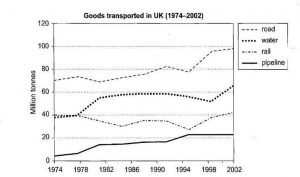Useful tips and link for vocabulary, content & paragraphs for IELTS writing task 1 line graphs.
Below I have listed some useful links to learn about IELTS line graphs. Line graphs are quite common in IELTS writing task 1.
There are six types of IELTS writing task 1 for the academic paper:
- line graph
- bar chart
- table
- map
- diagram
- pie charts
Sample IELTS Line Graph

Source: IELTS Cambridge English Test Books
You must prepare for all types of charts in academic writing task 1. You might also be given a combination of a line graph with a table for example. Writing task 1 is worth about 33% of your total writing marks so it’s worth learning well.
Tips for IELTS Line Graphs
Here are some useful tips for Line Graphs:
- Introduce the time frame and individual categories
- the overview will contain the main trends over the whole period – a bird’s eye view
- use language of change for line graphs: increase, drop, fluctuate etc (see below)
- vary your sentence structures: “the number of sales decreased over the period / there was a decrease in the number of sales …”
- support sentences in the body paragraphs with data – time frame and numbers
- don’t spend more than 20 mins on task 1
- make sure you have four paragraphs (occasionally five are possible)
- don’t overload your writing with small details – be selective
- aim for between 160 and 180 words
- task 1 is a report, not an essay
IELTS Line Graph Lessons
Click on the links below to access the pages to learn about line graphs:
- Nouns and Verbs for IELTS Line Graph
- Adjectives and Adverbs with Tips
- both the above links provide useful language to describe the changes in a line graph.
- Gap Fill Practice for Line Graph
- Two Lines Model Answer Exercise
- both the above links are exercises to practice using language for line graphs.
- Three Lines Model Answer
- Line Graph & Bar Chart Model
- both model answers above will help you understand more about describing line graphs
- Practice Charts for Academic IELTS Writing Task 1
- All my IELTS Writing Task 1 Tips & Model Answers












